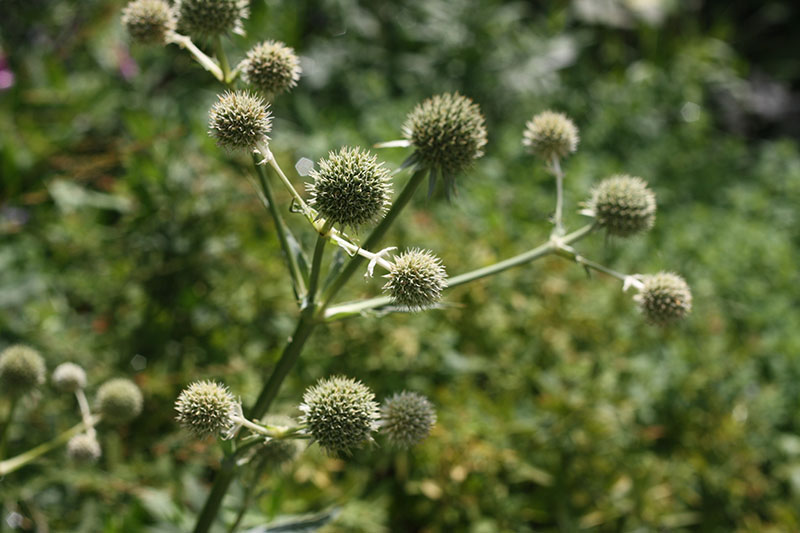Rattlesnake Master
Taxonomic Name: Eryngium yuccifolium cv. Prairie Moon
Common Name: Rattlesnake Master
Type: Herbaceous Perennial
Zone: 3, 4, 5, 6, 7, 8
Bloom Time: June to September
Height: 36-60 inches
Light Requirements: Full sun, Morning shade with afternoon sun, Morning sun with afternoon shade
Soil Conditions: Tolerates periodic drought, Average well-drained soil
Flower Color: White
Wildlife: Bees, Butterflies, Wasps
Special Characteristics: - Also known as Button snakeroot
- Member of the carrot family though it resembles a yucca plant with a thistle-like appearance
- Dried seed heads used to be used as rattles by Native Americans
- Mildly fragrant flower heads turn from white to purplish in fall then dark brown when dry
- Foliage is green, blueish or gray-green
- Rattlesnake master refers to an erroneous belief that the roots could be used as an antidote to rattlesnake bites
- Easily propagates from seed and will readily self-sow
- In shade, becomes spindly and may topple while in bloom
- Easy to grow
- Root has a central taproot and thus does not transplant well
- Best left as is once established
- Leave up for winter interest
- Drought tolerant
- Clay soil tolerant
- Deer tolerant
- Rabbit tolerant
Rattlesnake Master
Taxonomic Name: Eryngium yuccifolium cv. Prairie Moon
Common Name: Rattlesnake Master
Type: Herbaceous Perennial
Zone: 3, 4, 5, 6, 7, 8
Bloom Time: June to September
Height: 36-60 inches
Light Requirements: Full sun, Morning shade with afternoon sun, Morning sun with afternoon shade
Soil Conditions: Tolerates periodic drought, Average well-drained soil
Flower Color: White
Wildlife: Bees, Butterflies, Wasps
Special Characteristics: - Also known as Button snakeroot
- Member of the carrot family though it resembles a yucca plant with a thistle-like appearance
- Dried seed heads used to be used as rattles by Native Americans
- Mildly fragrant flower heads turn from white to purplish in fall then dark brown when dry
- Foliage is green, blueish or gray-green
- Rattlesnake master refers to an erroneous belief that the roots could be used as an antidote to rattlesnake bites
- Easily propagates from seed and will readily self-sow
- In shade, becomes spindly and may topple while in bloom
- Easy to grow
- Root has a central taproot and thus does not transplant well
- Best left as is once established
- Leave up for winter interest
- Drought tolerant
- Clay soil tolerant
- Deer tolerant
- Rabbit tolerant

